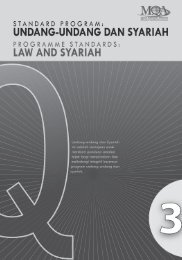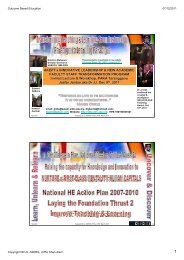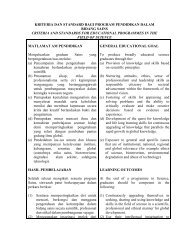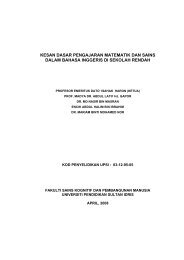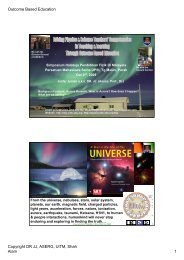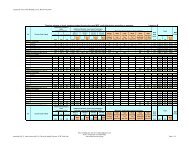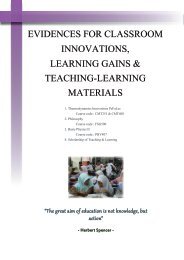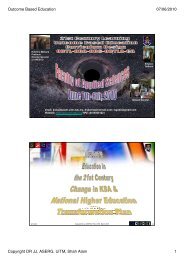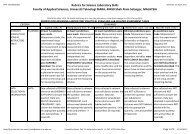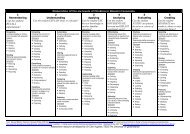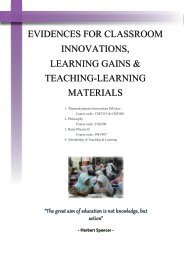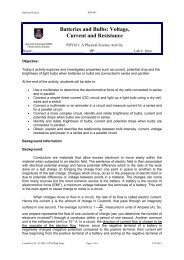Bloom's Taxonomy: Psychomotor Domain
Bloom's Taxonomy: Psychomotor Domain
Bloom's Taxonomy: Psychomotor Domain
Create successful ePaper yourself
Turn your PDF publications into a flip-book with our unique Google optimized e-Paper software.
APPENDIX A<br />
Taxonomies of Learning <strong>Domain</strong>s<br />
Activities at Various Cognitive Levels of Learning (LoL)<br />
Bloom‟s taxonomy of learning objectives is used to define how well a skill or competency is<br />
learned or mastered. A fuller description of Bloom‟s taxonomy is given in the following pages but<br />
a brief summary of the activities associated with each level is given below.<br />
1. At Knowledge Level of Learning a student can define terms<br />
2. At Comprehension Level of Learning a student can work assigned problems and can<br />
example what they did<br />
3. At Application Level of Learning a student recognizes what methods to used and then<br />
used the methods to solve problems<br />
4. At Analysis Level of Learning a student can explain why the solution process works<br />
5. At Synthesis Level of Learning a student can combine the part of a process in new and<br />
useful ways<br />
6. At Evaluation Level of Learning a student can create a variety of ways to solve the<br />
problem and then, based on established criteria, select the solution method best suited<br />
for the problem.<br />
KNOWLEDGE (INFORMATION)<br />
1. How do I know I have reached this level?<br />
I can recall information about the subject, topic, competency, or competency area; I<br />
can recall the appropriate material at the appropriate time. I have been exposed to and<br />
have received the information about the subject; thus, I can respond to questions,<br />
perform relevant tasks, etc.<br />
2. What do I do at this level?<br />
I read material, listen to lectures, watch videos, take notes; I pass „True/False‟, „Yes/No‟,<br />
„multiple choice‟, or „fill in the blank‟ tests which demonstrate my general knowledge of<br />
the subject. I learn the vocabulary or terminology as well as the conventions or rules<br />
associated with the subject.<br />
3. How will the teacher know I am at this level?<br />
The teacher will provide verbal or written tests on the subject that can be answered by<br />
simply recalling the material I have learned about this subject.<br />
4. What does the teacher do at this level?<br />
1
The teacher directs, tells, shows, identifies, examines the subject or competency area at<br />
this level.<br />
5. What are typical ways I can demonstrate my knowledge?<br />
a. Answer „True/False‟, „Yes/No‟, „fill in the blank‟, or „multiple choice‟ questions<br />
correctly.<br />
b. Define technical terms associated with the subject by stating their attributes,<br />
properties, or relations.<br />
c. Recall the major facts about the subject.<br />
d. Name the classes, sets, divisions, or arrangements that are fundamental to the<br />
subject.<br />
e. List the criteria used to evaluate facts, data, principles, or ideas associated with<br />
the subject.<br />
f. List the relevant principles and generalizations associated with the subject.<br />
g. List the characteristic methods of approaching and presenting ideas associated<br />
with the subject (e.g., list the conventions or rules associated with the subject).<br />
h. Describe the general problem solving method (i.e., the techniques and<br />
procedures) or the method(s) of inquiry commonly used in the subject area.<br />
6. What are typical work products?<br />
a. Answers to Knowledge level quizzes („True/False‟, „Yes/No‟, „fill in the blank‟, or<br />
„multiple choice‟).<br />
b. Lists of definitions or relevant principles and generalizations associated with the<br />
subject.<br />
c. Modifications of example problems presented in the textbook; for example,<br />
modest changes in numerical values or units; i.e., solutions to problems which<br />
were solved using „pattern recognition‟.<br />
7. What are descriptive ‘process’ verbs?<br />
define label listen list memorize name<br />
read recall record relate repeat view<br />
COMPREHENSION (UNDERSTANDING)<br />
1. How do I know I have reached this level?<br />
I comprehend or understand the subject, topic, competency, or competency area; I use<br />
ideas associated with the subject without relating them to other ideas or subjects. I may<br />
not yet completely understand the subject. When others are discussing this subject, I<br />
can follow and understand the discussion. This level requires Knowledge.<br />
2. What do I do at this level?<br />
2
I successfully solve textbook problems using appropriate techniques and procedures<br />
based on (1) where the problem is located in the book or (2) the problem statement. I<br />
translate ideas into my own words (translation from one level of abstraction to another). I<br />
translate graphical or symbolic information (e.g., tables, diagrams, graphs, mathematical<br />
formulas, etc.) into verbal forms, and vice versa. I interpret or summarize<br />
communications (oral/written/graphical). I can use the problem solution to determine<br />
effects, trends, implications, corollaries, etc.<br />
3. How will the teacher know I am at this level?<br />
The teacher will ask questions that can be answered by restating or reorganizing<br />
material in a literal manner; i.e., by clearly stating facts or the principle meaning of the<br />
material in your own words. The teacher will also give tests based on the textbook<br />
problems that were (1) assigned as homework or (2) used as examples in the textbook<br />
or in class.<br />
4. What does the teacher do at this level?<br />
The teacher demonstrates, solves problems, listens, questions, compares, contrasts,<br />
and examines the information and your knowledge of the subject.<br />
5. What are typical ways I can demonstrate, on my own, my comprehension and<br />
understanding?<br />
a. Read textbook problems, understand what is required, and successfully solve the<br />
problems.<br />
b. Clearly document the process used to solve the problem.<br />
c. Clearly describe the solution to the problem.<br />
d. Draw conclusions based on the solution to the problem.<br />
e. Compare/contrast two different textbook problems (i.e., what elements are the<br />
same? what elements are different?).<br />
f. Restate an idea, theory, or principle in your own words.<br />
6. What are typical work products?<br />
a. Answers to Comprehension level quizzes and exams („multiple choice‟ or<br />
textbook problems).<br />
b. Solutions to textbook problems which include (a) a summary of the learning<br />
objectives associated with the problem, (b) the problem statement in the form of<br />
a clearly labeled sketch, specifications, and what is required, (c) a description of<br />
the general solution method (techniques and procedures) used to solve the<br />
problem, and (d) a discussion of the solution.<br />
7. What are descriptive ‘process’ verbs?<br />
describe discuss explain express identify locate<br />
recognize report restate review solve tell<br />
3
APPLICATION (INDEPENDENT PROBLEM SOLVING)<br />
1. How do I know I have reached this level?<br />
I can recognize the need to use an idea, concept, principle, theory, or general solution<br />
methods (techniques and procedures) without being told and without any specific or<br />
immediate context or cues. For example, I do not need to locate a similar example in a<br />
textbook, nor do I need to know that an assignment is for a particular course in order to<br />
recognize the need to use a particular idea, etc. I know and comprehend these ideas,<br />
concepts, principles, theories, or general solution methods (techniques and procedures<br />
and I can apply them to new situations. I also have the ability to recognize when a<br />
certain task or project is beyond my current competency. This level<br />
requires Knowledge and Comprehension.<br />
2. What do I do at this level?<br />
I apply ideas, concepts, principles, theories, or general solution methods (techniques<br />
and procedures) that I learned at the Knowledge and Comprehension level to new<br />
situations. I solve problems in which the solution method is not immediately evident or<br />
obvious. I solve these problems independently and make use of other techniques and<br />
procedures as well. This requires not only knowing and comprehending these ideas,<br />
concepts, principles, theories, and general solution methods (techniques and<br />
procedures) but deep thinking about their usefulness and how they can be used to solve<br />
new problems that I identify or define.<br />
3. How will the teacher know I am at this level?<br />
The teacher will review my work products and confirm that I am solving problems<br />
independently, in new situations, and without prompting by the teacher. The teacher will<br />
be able to pose general questions such as "How much protection from the sun is<br />
enough?" and I will know how to answer the question by defining and solving a problem.<br />
4. What does the teacher do at this level?<br />
The teacher assigns problems that do not explicitly (or as best possible implicitly) imply<br />
the use of an expected solution methodology. The teacher may develop problems and<br />
assignments in conjunction with teachers in another related subject areas. The teacher<br />
will probe for use of course material outside of the course.<br />
5. What are the typical ways I can demonstrate, on my own, my Application of Knowledge<br />
and Comprehension?<br />
a. Solve problems which require that I recognize and apply the appropriate ideas,<br />
concepts, principles, theories, general solution methods (techniques and<br />
procedures), etc. without being told and without any specific or immediate<br />
context or cues.<br />
b. Apply the laws of mathematics, chemistry, and physics, as well as engineering,<br />
business or design concepts, etc. to practical problems or situations.<br />
c. Solve problems associated with design/build projects.<br />
4
6. What are typical work products?<br />
Application level work products are very similar to Comprehension level work products;<br />
however, documentation will be included which demonstrates that you recognized the<br />
need to use ideas, concepts, principles, theories, general solution methods (techniques<br />
and procedures), etc. in a new situation.<br />
7. What are descriptive ‘process’ verbs?<br />
apply demonstrate employ illustrate interpret<br />
operate practice recognize solve use<br />
ANALYSIS (LOGICAL ORDER, COMPONENTS)<br />
1. How do I know I have reached this level?<br />
I can explain why. I can methodically examine ideas, concepts, principles, theories,<br />
general solution methods (techniques and procedures), reports, etc. and separate these<br />
into their component parts or basic elements. I can use the results of this examination to<br />
clarify the organization of the whole or to gain a global view. This level requires<br />
Knowledge and Comprehension Levels of Learning; Application is not required.<br />
2. What do I do at this level?<br />
I demonstrate that I can analyze results by breaking ideas, concepts, principles,<br />
theories, general solution methods (techniques and procedures), reports, etc. into their<br />
component parts. I explain the logical interconnections of the parts. I can also develop<br />
detailed cause and effect sequences.<br />
3. How will the teacher know I am at this level?<br />
When asked, I am able to explain why I did what I did. I include a discussion with my<br />
work that explains why my solution method worked.<br />
4. What does the teacher do at this level?<br />
The teacher probes, guides, observes, and acts as a resource or facilitator.<br />
5. What are typical questions I can ask myself that will demonstrate my Analysis Level of<br />
Learning?<br />
a. What are the causal relationships between the parts and how the whole<br />
functions?<br />
b. Can I explain, from the parts, why the whole does or does not work?<br />
c. Are the conclusions supported by sound reasoning?<br />
d. Does the evidence provided support the hypothesis or the conclusion?<br />
e. Are the conclusions supported by facts, opinions, or an analysis of the results?<br />
5
f. What are the unstated assumptions, if any?<br />
6. What are typical work products?<br />
a. Answers to Analysis level exams (problems, multiple choice, and essays).<br />
b. Analysis level work products are very similar to Comprehension level work<br />
products; however, documentation will include a more extensive discussion of<br />
the work. The content, amount, and depth of the presentation is what<br />
distinguishes Analysis level work products from Comprehension level work<br />
products; e.g., see items a. through f. above.<br />
7. What are descriptive „process‟ verbs?<br />
SYNTHESIS (CREATE)<br />
analyze appraise break apart break down calculate<br />
compare contrast debate diagram differentiate<br />
examine experiment explain inspect inventory<br />
question relate solve<br />
1. How do I know I have reached this level?<br />
I have the ability to assemble parts and elements into a unified organization or whole<br />
that requires original or creative thinking. I recognize new problems and develop new<br />
tools to solve them. I create my own plans, models, hypotheses, etc. for constructing<br />
solutions to problems. This Level of Learning requires Knowledge, Comprehension,<br />
Application and Analysis Levels of Learning.<br />
2. What do I do at this level?<br />
I generate ideas and use them to create a physical object, a process, a design method,<br />
a written or oral communication, or even a set of abstract relations (e.g., mathematical<br />
models). I produce written or oral reports that have the desired effect (e.g., information<br />
acquisition, acceptance of a point of view, continued support, etc.) on the reader or<br />
listener. I generate project plans. I propose designs. I formulate hypotheses based on<br />
the analysis of relevant or pertinent factors. I am able to generalize from a set of axioms<br />
or principles.<br />
3. How will the teacher know I am at this level?<br />
6
I demonstrate that I can combine ideas into a statement, a plan, a product, etc. that was<br />
previously unknown to me; e.g., I develop a program that includes the best parts of each<br />
of these ideas.<br />
4. What does the teacher do as this level?<br />
The teacher reflects, extends, analyzes, and evaluates.<br />
5. What are the typical questions I can ask myself that will demonstrate my Synthesis Level<br />
of Learning?<br />
a. Can I create a project plan?<br />
b. Can I develop a model?<br />
c. Can I propose a design?<br />
6. What are typical work products?<br />
a. Answers to Synthesis level exams (problems, multiple choice, and essays).<br />
b. Synthesis level work products are very similar to Comprehension level work<br />
products; however, documentation will include a more extensive discussion of<br />
the work. The content, amount, and depth of the presentation is what<br />
distinguishes Synthesis level work products from Comprehension level work<br />
products; e.g., see items a. through c. above.<br />
7. What are descriptive „process‟ verbs?<br />
EVALUATION (APPRECIATION)<br />
Arrange assemble collect compose construct<br />
create design formulate manage organize<br />
plan prepare propose set up write<br />
1. How do I know I have reached this level?<br />
I have the ability to judge and appreciate the value of ideas, concepts, principles,<br />
theories, or general solution methods (techniques and procedures) using appropriate<br />
criteria. This level requires Knowledge, Comprehension, Application, Analysis, and<br />
Synthesis Levels of Learning.<br />
2. What do I do at this level?<br />
I make value judgments based on certain criteria such as usefulness and effectiveness.<br />
Based on information gained through application, analysis, and synthesis, I can<br />
rationally select a process, a method, a model, a design, etc. from among a set of<br />
possible processes, methods, models, designs, etc. I evaluate competing plans of action<br />
7
efore actually starting the work. I evaluate work products based on internal standards of<br />
consistency, logical accuracy, and the absence of internal flaws; e.g., I can certify that<br />
the feasibility of a design has been demonstrated in a report. I evaluate work products<br />
based on external standards of efficiency, cost, or utility to meet particular goals or<br />
objectives; e.g., I can certify that the quality of the design has been demonstrated in a<br />
report.<br />
3. How will the teacher know I am at this level?<br />
I demonstrate that I can select, judge, or appreciate a process, a method, a model, a<br />
design, etc. using appropriate criteria or standards.<br />
4. What does the teacher do at this level?<br />
The teacher clarifies, accepts, harmonizes, aligns, and guides.<br />
5. What are typical statements and questions I can answer to that will demonstrate or show<br />
my appreciation/evaluation?<br />
a. I can evaluate an idea in terms of ...<br />
b. For what reasons do I favor...?<br />
c. Which policy do I think would result in the greatest good for the greatest number?<br />
d. Which of these models or modeling approaches is best for my current needs?<br />
e. How does this report demonstrate that the design is feasible?<br />
f. How does this report demonstrate the quality of the design?<br />
6. What are typical work products?<br />
a. Answers to Evaluation level exams (problems, multiple choice, and essays).<br />
b. Evaluation level work products are very similar to Comprehension level work<br />
products; however, documentation will include a more extensive discussion of<br />
the work. The content, amount, and depth of the presentation is what<br />
distinguishes Evaluation level work products from Comprehension level work<br />
products; e.g., see items a through f above.<br />
7. What are descriptive „process‟ verbs?<br />
appraise assess choose compare estimate<br />
(quality)<br />
evaluate judge predict (quality) rate value select<br />
8
Bloom’s Revised <strong>Taxonomy</strong> – Knowledge Dimensions (Types of Knowledge)<br />
Category Examples<br />
Factual knowledge: The basic elements candidates must know to be acquainted with a<br />
discipline.<br />
Technical vocabulary, knowledge of symbols,<br />
Knowledge of terminology.<br />
knowledge of measures, knowledge of acronyms<br />
and abbreviations.<br />
History of the Internet, descriptions of features of<br />
Knowledge of specific details.<br />
specific WP program, sources of information,<br />
knowledge of a programming language.<br />
Conceptual knowledge: The relationships between components or systems.<br />
Knowledge of classifications.<br />
Types of programming language, types of computer<br />
system.<br />
Knowledge of systems.<br />
Basic structure of a computer, ISO reference<br />
model, knowledge of a specific operating system.<br />
Knowledge of principles and<br />
Stored program concept, programming<br />
generalisations.<br />
techniques, Moores Law.<br />
Knowledge of theories, models and Program testing strategies, SSADM, program<br />
structures.<br />
design, JSP.<br />
Procedural knowledge: How to do something, methods of research, criteria for using<br />
methods and techniques.<br />
Knowledge of subject-specific skills and<br />
algorithms.<br />
Knowledge of how to use an application package,<br />
knowledge of how to write a computer program,<br />
sorting and searching algorithms.<br />
Knowledge of subject-specific<br />
Top-down program design, normalisation,<br />
techniques and methods.<br />
structured programming, systematic fault-finding.<br />
Knowledge of criteria for using<br />
procedures.<br />
Knowledge of when to use a specific algorithm,<br />
knowledge of criteria for selecting a type of<br />
applications package.<br />
Meta knowledge: Knowledge of knowledge.<br />
Strategic knowledge.<br />
Knowledge about cognitive tasks.<br />
Self knowledge.<br />
Knowledge of learning strategies, knowledge of the<br />
use of heuristics, knowledge of mind mapping.<br />
Knowledge about the relative complexity of different<br />
procedures, exam technique.<br />
Awareness of personal strengths and weaknesses,<br />
awareness of extent of own knowledge about a<br />
particular topic.<br />
9
Bloom’s revised <strong>Taxonomy</strong> – Depth of Knowledge (Cognitive Process)<br />
Cognitive<br />
ability<br />
Keywords Definitions and examples<br />
Remember: Retrieve relevant knowledge from memory.<br />
Identify Matching descriptions with visual representations. For<br />
Recognising Match example, identifying the components of a microcomputer<br />
system.<br />
State<br />
Retrieving knowledge from long-term memory. For<br />
Recalling Define example, stating four characteristics of information or<br />
Describe defining the meaning of an acronym.<br />
Understand: Construct meaning from instructions.<br />
Estimate Changing from one form of representation to another. For<br />
Interpreting<br />
Convert<br />
Translate<br />
Give<br />
example, interpreting an advert for computer hardware or<br />
converting one unit or measurement to another (e.g. bytes<br />
to megabytes).<br />
examples Finding a specific example of a concept or principle. For<br />
Exemplifying Illustrate example, relating a specific packages features to the<br />
Demonstrate<br />
Show<br />
generic features of a type of package.<br />
Arrange Assigning something to a specific class or category or re-<br />
Classifying<br />
Classify<br />
Categorise<br />
ordering a list. For example, classifying specific software<br />
products by software type (freeware, shareware,<br />
Sort<br />
commercial etc.).<br />
Summarising<br />
Summarise<br />
Review<br />
Abstracting a general theme or major points. For example,<br />
writing a short review of a specific software product.<br />
Predict Drawing a conclusion from presented information. For<br />
Inferring Deduce example, given a number of specific cases, produce rules<br />
Extrapolate using an expert system.<br />
Comparing<br />
Compare<br />
Contrast<br />
Evaluate<br />
Map<br />
Detecting correspondences between ideas and/or objects.<br />
For example, contrast two programming languages in<br />
terms of their data structure facilities.<br />
Explaining<br />
Give reasons<br />
Explain<br />
Justify<br />
Constructing a cause-and-effect model of a system. For<br />
example, give reasons for the emergence of the Internet.<br />
Apply: Carry out or use a procedure in a given situation.<br />
Carry out Applying a procedure to a familiar task. For example,<br />
Executing Perform carrying out the procedure to install an applications<br />
Complete package on a PC.<br />
Use<br />
Applying a procedure to an unfamiliar task. For example,<br />
Implementing Apply using applications software to solve a given problem or<br />
Implement writing a piece of code to perform a specific task.<br />
Analyse: Break material into its constituent parts and determine how these parts relate to one<br />
another and to the overall structure or purpose.<br />
Select Identifying similarities and differences, and important and<br />
Differentiating Choose unimportant attributes of objects or systems. For example,<br />
Discriminate choosing a computer system (from two or more provided)<br />
10
Cognitive<br />
ability<br />
Keywords Definitions and examples<br />
for a specific task, or selecting a specific data structure to<br />
model a given problem.<br />
Arrange Determining how elements fit together within a system.<br />
Organising<br />
Find<br />
Structure<br />
For example, constructing a flowchart to represent a given<br />
problem description or producing a data flow diagram to<br />
Organise model a supplied case study.<br />
Assign Determine a point of view, bias, values or intent. For<br />
Attributing Attribute example, determining the point of view of an author of an<br />
Deconstruct essay on the social implications of IT.<br />
Evaluate: Make judgements based on criteria and standards.<br />
Check<br />
Verify Determining inconsistencies or fallacies within a process<br />
Checking Confirm or product. For example, dry running a given algorithm to<br />
Monitor<br />
Test<br />
Evaluate<br />
check its correctness or testing a program to locate errors.<br />
Critiquing<br />
Comment on<br />
Review<br />
Appraise<br />
Critique<br />
Judge<br />
Critically<br />
assess<br />
Detecting the appropriateness of a given procedure for a<br />
given problem; measuring a product or process using<br />
criteria. For example, judging the appropriateness of two<br />
algorithms for a given situation, or evaluating the data<br />
security arrangements for a specific scenario.<br />
Create: Put elements together to form a coherent or functional whole; re-organise elements<br />
into a new pattern.<br />
Generating<br />
Suggest<br />
Produce<br />
Hypothesise<br />
Imagine<br />
Producing alternative hypotheses based on criteria. For<br />
example, given a description of a hardware error, propose<br />
possible causes.<br />
Plan<br />
Devising a procedure for accomplishing a task. For<br />
Planning<br />
Design<br />
Set-up<br />
Produce<br />
example, designing a problem solving routine to diagnose<br />
and correct hardware problems or planning the creation of<br />
a new software product.<br />
Producing<br />
Make<br />
Construct<br />
Create<br />
Inventing a product. For example, creating a new piece of<br />
software or constructing a Web site.<br />
11
1<br />
Remembering<br />
Can the student<br />
RECALL information?<br />
Recognising<br />
Locating knowledge in memory<br />
that is consistent with<br />
presented material.<br />
Synonyms<br />
Identifying<br />
Finding<br />
Selecting<br />
Indicating<br />
Recalling<br />
Retrieving relevant knowledge<br />
from long-term memory.<br />
Synonyms<br />
Retrieving<br />
Naming<br />
Reproducing<br />
Recounting<br />
Elaboration of the six levels of thinking in Bloom’s taxonomy<br />
2<br />
Understanding<br />
Can the student EXPLAIN ideas<br />
or concepts?<br />
Interpreting<br />
Changing from one<br />
form of representation<br />
to another<br />
Synonyms:<br />
Paraphrasing<br />
Translating<br />
Representing<br />
Clarifying<br />
Converting<br />
Rewriting<br />
Restating<br />
Expressing<br />
Exemplifying<br />
Finding a specific<br />
example or illustration<br />
of a concept or<br />
principle<br />
Synonyms<br />
Instantiating<br />
Illustrating...<br />
Representing<br />
Giving examples of<br />
Showing<br />
Classifying<br />
Determining that<br />
something belongs to a<br />
category (e.g., concept<br />
or principle).<br />
Synonyms<br />
Categorising<br />
Summarising<br />
Drawing a logical<br />
conclusion from<br />
presented<br />
information.<br />
Synonyms<br />
Abstracting<br />
Generalising<br />
Outlining<br />
Précising<br />
Inferring<br />
Abstracting a general<br />
theme or major point<br />
Synonyms<br />
Extrapolating<br />
Interpolating<br />
Predicting<br />
Concluding<br />
Extending<br />
Generalising<br />
Comparing<br />
Detecting<br />
correspondences<br />
between two ideas,<br />
objects, etc<br />
Synonyms<br />
Contrasting<br />
Matching<br />
Mapping<br />
Explaining<br />
Constructing a cause-<br />
3<br />
Applying<br />
Can the student<br />
USE the new<br />
knowledge in<br />
another familiar<br />
situation?<br />
Executing<br />
Applying knowledge (often<br />
procedural) to a routine<br />
task.<br />
Synonyms<br />
Carrying out<br />
Measuring<br />
Constructing<br />
Demonstrating<br />
Computing<br />
Calculating<br />
Manipulating<br />
Operating<br />
Preparing<br />
Producing<br />
Drawing up<br />
Practising<br />
Implementing<br />
Applying knowledge (often<br />
procedural) to a non-routine<br />
task.<br />
Synonyms<br />
Using<br />
Estimating<br />
Predicting<br />
Solving<br />
Changing<br />
Discovering<br />
Explaining how<br />
Verifying<br />
4<br />
Analysing<br />
Can the student<br />
DIFFERENTIATE<br />
between and RELATE<br />
constituent parts?<br />
Differentiating<br />
Distinguishing relevant from<br />
irrelevant parts or important from<br />
unimportant parts of presented<br />
material.<br />
Synonyms<br />
Discriminating<br />
Selecting<br />
Focusing<br />
Distinguishing between<br />
Separating<br />
(Sub)dividing<br />
Examining<br />
Relating<br />
Organising<br />
Determining how elements fit or<br />
function within a structure.<br />
Synonyms<br />
Outlining<br />
Structuring<br />
Integrating<br />
(Re)arranging<br />
Categorising<br />
Ordering<br />
Deriving<br />
Attributing<br />
Determining the point of view, bias,<br />
values, or intent underlying<br />
presented material.<br />
Synonyms<br />
Deconstructing<br />
5<br />
Evaluating<br />
Can the student<br />
JUSTIFY an<br />
opinion, decision<br />
or course of<br />
action?<br />
Checking<br />
Detecting inconsistencies<br />
or fallacies within a process<br />
or product.<br />
Determining whether a<br />
process or product has<br />
internal consistency.<br />
Synonyms<br />
Testing<br />
Detecting<br />
Monitoring<br />
Concluding<br />
Assessing<br />
Appraising<br />
Discriminating<br />
Determining<br />
Critiquing<br />
Detecting the<br />
appropriateness of a<br />
procedure for a given task<br />
or problem.<br />
Synonyms<br />
Judging<br />
Questioning<br />
Justifying<br />
Defending<br />
Discussing<br />
Criticising<br />
Arguing<br />
Including<br />
Rating<br />
6<br />
Creating<br />
Can the student<br />
GENERATE new<br />
products, ideas or<br />
ways of viewing<br />
things?<br />
Generating<br />
Coming up with alternatives or<br />
hypotheses based on criteria<br />
Synonyms<br />
Hypothesizing<br />
Proposing<br />
Developing<br />
Engendering<br />
Synthesising<br />
Providing options<br />
Planning<br />
Devising a procedure for<br />
accomplishing some task.<br />
Synonyms<br />
Designing<br />
Formulating<br />
Combining<br />
Compiling<br />
Devising<br />
Revising<br />
Putting together<br />
Suggesting<br />
Producing<br />
Inventing a product<br />
Synonyms<br />
(Re)constructing<br />
Composing<br />
Modifying<br />
Altering<br />
Building<br />
12
1<br />
Remembering<br />
Can the student<br />
RECALL information?<br />
Elaboration of the six levels of thinking in Bloom’s taxonomy<br />
2<br />
Understanding<br />
Can the student EXPLAIN ideas<br />
or concepts?<br />
Subsuming<br />
Organising<br />
and-effect model of a<br />
system.<br />
Synonyms<br />
Elucidating<br />
Constructing<br />
models<br />
3<br />
Applying<br />
Can the student<br />
USE the new<br />
knowledge in<br />
another familiar<br />
situation?<br />
Finding<br />
4<br />
Analysing<br />
Can the student<br />
DIFFERENTIATE<br />
between and RELATE<br />
constituent parts?<br />
Comparing<br />
Contrast ing<br />
Diagnosing<br />
5<br />
Evaluating<br />
Can the student<br />
JUSTIFY an<br />
opinion, decision<br />
or course of<br />
action?<br />
Ranking<br />
Valuing<br />
6<br />
Creating<br />
Can the student<br />
GENERATE new<br />
products, ideas or<br />
ways of viewing<br />
things?<br />
Enlarging<br />
13
<strong>Psychomotor</strong> <strong>Domain</strong> – Simpson’s Model<br />
<strong>Psychomotor</strong> <strong>Domain</strong> (Simpson)<br />
Lev<br />
el<br />
category or<br />
'level'<br />
1 Perception<br />
2 Set<br />
3<br />
Guided<br />
Response<br />
Description<br />
Awareness, the ability to use sensory<br />
cues to guide physical activity. The<br />
ability to use sensory cues to guide<br />
motor activity. This ranges from sensory<br />
stimulation, through cue selection, to<br />
translation.<br />
Readiness, a learner's readiness to act.<br />
Readiness to act. It includes mental,<br />
physical, and emotional sets. These<br />
three sets are dispositions that<br />
predetermine a person‟s response to<br />
different situations (sometimes called<br />
mindsets).<br />
Attempt. The early stages in learning a<br />
complex skill that includes imitation and<br />
Examples of activity or demonstration and<br />
evidence to be measured<br />
use and/or selection of senses to absorb<br />
data for guiding movement<br />
Examples: Detects non-verbal<br />
communication cues. Estimate where a<br />
ball will land after it is thrown and then<br />
moving to the correct location to catch the<br />
ball. Adjusts heat of stove to correct<br />
temperature by smell and taste of food.<br />
Adjusts the height of the forks on a forklift<br />
by comparing where the forks are in<br />
relation to the pallet.<br />
“By the end of the music theatre program,<br />
students will be able to relate types of<br />
music to particular dance steps.”<br />
mental, physical or emotional preparation<br />
before experience or task<br />
Examples: Knows and acts upon a<br />
sequence of steps in a manufacturing<br />
process. Recognize one‟s abilities and<br />
limitations. Shows desire to learn a new<br />
process (motivation). NOTE: This<br />
subdivision of <strong>Psychomotor</strong> is closely<br />
related with the "Responding to<br />
phenomena" subdivision of the Affective<br />
domain.<br />
“By the end of the physical education<br />
program, students will be able to<br />
demonstrate the proper stance for batting<br />
a ball.”<br />
imitate or follow instruction, trial and error.<br />
Examples: Performs a mathematical<br />
Action verbs which describe the<br />
activity to be trained or<br />
measured at each level)<br />
chooses, describes, detects,<br />
differentiates, distinguishes,<br />
feels, hears, identifies, isolates,<br />
notices, recognizes, relates,<br />
selects, separates, touches,<br />
arranges, begins, displays,<br />
explains, gets set, moves,<br />
prepares, proceeds, reacts,<br />
shows, states, volunteers,<br />
responds, starts,<br />
assembles, builds, calibrates,<br />
15
<strong>Psychomotor</strong> <strong>Domain</strong> (Simpson)<br />
Lev<br />
el<br />
category or<br />
'level'<br />
4 Mechanism<br />
level<br />
5<br />
category or<br />
'level'<br />
Complex<br />
Overt<br />
Response<br />
Description<br />
trial and error. Adequacy of performance<br />
is achieved by practicing.<br />
basic proficiency, the ability to perform a<br />
complex motor skill.<br />
This is the intermediate stage in learning<br />
a complex skill. Learned responses<br />
have become habitual and the<br />
movements can be performed with<br />
some confidence and proficiency.<br />
Description<br />
expert proficiency, the intermediate<br />
stage of learning a complex skill.<br />
The skillful performance of motor acts<br />
that involve complex movement<br />
patterns.<br />
Proficiency is indicated by a quick,<br />
accurate, and highly coordinated<br />
performance, requiring a minimum of<br />
energy. This category includes<br />
performing without hesitation, and<br />
automatic performance. For example,<br />
players are often utter sounds of<br />
satisfaction or expletives as soon as<br />
they hit a tennis ball or throw a football,<br />
Examples of activity or demonstration and<br />
evidence to be measured<br />
equation as demonstrated. Follows<br />
instructions to build a model. Responds<br />
hand-signals of instructor while learning<br />
to operate a forklift.<br />
“By the end of the physical education<br />
program, students will be able to perform<br />
a golf swing as demonstrated by the<br />
instructor.”<br />
competently respond to stimulus for<br />
action<br />
Examples: Use a personal computer.<br />
Repair a leaking faucet. Drive a car.<br />
“By the end of the biology program,<br />
students will be able to assemble<br />
laboratory equipment appropriate for<br />
experiments.”<br />
Examples of activity or demonstration and<br />
evidence to be measured<br />
Execute a complex process with expertise<br />
Examples: Maneuvers a car into a tight<br />
parallel parking spot. Operates a<br />
computer quickly and accurately. Displays<br />
competence while playing the piano.<br />
“By the end of the industrial education<br />
program, students will be able to<br />
demonstrate proper use of woodworking<br />
tools to high school students.”<br />
Action verbs which describe the<br />
activity to be trained or<br />
measured at each level)<br />
constructs, copies, dismantles,<br />
displays, dissects, fastens,<br />
fixes, follows, grinds, heats,<br />
imitates, manipulates,<br />
measures, mends, mixes,<br />
reacts, reproduces, responds<br />
sketches, traces, tries.<br />
assembles, builds, calibrates,<br />
completes, constructs,<br />
dismantles, displays, fastens,<br />
fixes, grinds, heats, makes,<br />
manipulates, measures, mends,<br />
mixes, organizes, performs,<br />
shapes, sketches.<br />
Action verbs which describe the<br />
activity to be trained or<br />
measured at each level)<br />
assembles, builds, calibrates,<br />
constructs, coordinates,<br />
demonstrates, dismantles,<br />
displays, dissects, fastens,<br />
fixes, grinds, heats,<br />
manipulates, measures, mends,<br />
mixes, organizes, sketches.<br />
NOTE: The key words are the<br />
same as Mechanism, but will<br />
have adverbs or adjectives that<br />
indicate that the performance is<br />
quicker, better, more accurate,<br />
16
<strong>Psychomotor</strong> <strong>Domain</strong> (Simpson)<br />
Lev<br />
el<br />
category or<br />
'level'<br />
6 Adaptation<br />
7 Origination<br />
Description<br />
because they can tell by the feel of the<br />
act what the result will produce.<br />
adaptable proficiency, a learner's ability<br />
to modify motor skills to fit a new<br />
situation.<br />
Skills are well developed and the<br />
individual can modify movement<br />
patterns to fit special requirements.<br />
creative proficiency, a learner's ability to<br />
create new movement patterns.<br />
Creating new movement patterns to fit a<br />
particular situation or specific problem.<br />
Learning outcomes emphasize creativity<br />
based upon highly developed skills.<br />
Examples of activity or demonstration and<br />
evidence to be measured<br />
alter response to reliably meet varying<br />
challenges<br />
Examples: Responds effectively to<br />
unexpected experiences. Modifies<br />
instruction to meet the needs of the<br />
learners. Perform a task with a machine<br />
that it was not originally intended to do<br />
(machine is not damaged and there is no<br />
danger in performing the new task).<br />
“By the end of the industrial education<br />
program, students will be able to adapt<br />
their lessons on woodworking skills for<br />
disabled students.”<br />
develop and execute new integrated<br />
responses and activities<br />
Examples: Constructs a new theory.<br />
Develops a new and comprehensive<br />
training programming. Creates a new<br />
gymnastic routine.<br />
Action verbs which describe the<br />
activity to be trained or<br />
measured at each level)<br />
etc.<br />
adapts, adjusts, alters,<br />
changes, integrates,<br />
rearranges, reorganizes,<br />
revises, solves, varies.<br />
arranges, builds, combines,<br />
composes, constructs, creates,<br />
designs, formulates, initiate,<br />
makes, modifies, originates, redesigns,<br />
trouble-shoots.<br />
Adapted and simplified representation of Simpson's <strong>Psychomotor</strong> <strong>Domain</strong> ('The classification of educational objectives in the psychomotor<br />
domain', 1972). Elizabeth Simpson seems actually to have first presented her <strong>Psychomotor</strong> <strong>Domain</strong> interpretation in 1966 in the Illinois<br />
Journal of Home Economics. Hence you may see the theory attributed to either 1966 or 1972.<br />
17
The Affective <strong>Domain</strong><br />
http://www.humboldt.edu/~tha1/bloomtax.html & http://academic.udayton.edu/health/syllabi/health/lesson01b.htm<br />
The Affective <strong>Domain</strong> addresses interests, attitudes, opinions, appreciations, values, and emotional sets. This domain includes the manner<br />
in which we deal with things emotionally, such as feelings, values, appreciation, enthusiasms, motivations, and attitudes. The <strong>Taxonomy</strong> is<br />
hierarchical (levels increase in difficulty/sophistication) and cumulative (each level builds on and subsumes the ones below). The levels, in<br />
addition to clarifying instructional objectives, may be used to provide a basis for questioning that ensures that students progress to the<br />
highest level of understanding. If the teaching purpose is to change attitudes/behavior rather than to transmit/process information, then the<br />
instruction should be structured to progress through the levels of the Affective <strong>Domain</strong>.<br />
Level Category Description Examples Action Verbs<br />
1 Receiving The student passively attends to<br />
particular phenomena or stimuli<br />
[classroom activities, textbook, music,<br />
etc.] The teacher's concern is that the<br />
student's attention is focused.<br />
Intended outcomes include the pupil's<br />
awareness that a thing exists.<br />
Emphasis is on awareness,<br />
willingness to hear, selected attention.<br />
2 Responding The student actively participates. The<br />
pupil not only attends to the stimulus<br />
but reacts in some way.<br />
Emphasis is on active participation on<br />
the part of the learners. Learning<br />
outcomes may emphasize compliance<br />
in responding, willingness to respond,<br />
or satisfaction in responding<br />
(motivation).<br />
Listens attentively, shows<br />
sensitivity to social problems.<br />
Listens to others with respect.<br />
Listens for and remembers the<br />
name of newly<br />
“By the end of the women's<br />
studies program, students will<br />
listen attentively to alternative<br />
views on select issues.”<br />
Completes homework, obeys<br />
rules, participates in class<br />
discussion, shows interest in<br />
subject, enjoys helping others.<br />
Gives a presentation. Questions<br />
new ideals, concepts, models, in<br />
order to fully understand them.<br />
Knows safety rules and practices<br />
them.<br />
“By the end of the elementary<br />
education program, students will<br />
Assoc. Prof. Dr. J.J. HP: 0193551621; Page 18 of 24 7/27/2011<br />
Attends, accepts, asks, chooses,<br />
describes, follows, gives, holds,<br />
identifies, listens, locates, names,<br />
points to, selects, selectively<br />
attends to, replies, uses.<br />
Acclaims, aids, answers,<br />
applauds, approves, assists,<br />
complies, conforms, discusses,<br />
greets, helps, labels, performs,<br />
practices, presents, reads,<br />
recites, reports, selects, tells,<br />
writes,<br />
Volunteers.<br />
18
Level Category Description Examples Action Verbs<br />
able to comply with PL 94-142.”<br />
3 Valuing The worth a student attaches to a<br />
particular object, phenomenon, or<br />
behavior. Ranges from acceptance to<br />
commitment (e.g., assumes<br />
responsibility for the functioning of a<br />
group). Attitudes and appreciation.<br />
Valuing is based on the internalization<br />
of a set of specified values, while clues<br />
to these values are expressed in the<br />
learner‟s overt behavior and are often<br />
identifiable.<br />
Demonstrates belief in<br />
democratic processes,<br />
appreciates the role of science in<br />
daily life, shows concern for<br />
others' welfare, demonstrates a<br />
problem-solving approach.<br />
Is sensitive towards individual<br />
and cultural differences (value<br />
diversity). Shows the ability to<br />
solve problems. Proposes a plan<br />
to bring about social<br />
improvement and follows through<br />
with commitment. Informs<br />
management on strongly felt<br />
matters.<br />
“By the end of the political<br />
science program, students will be<br />
able to debate numerous sides to<br />
an argument.”<br />
Assoc. Prof. Dr. J.J. HP: 0193551621; Page 19 of 24 7/27/2011<br />
Assists, completes, debates,<br />
demonstrates, denies,<br />
differentiates, explains, follows,<br />
forms, increases proficiency in,<br />
initiates, invites, joins, justifies,<br />
proposes, protests, reads,<br />
relinquishes, reports, selects,<br />
shares, studies, supports, works.<br />
Level Category Description Examples Action Verbs<br />
4 Organization Brings together different values,<br />
resolving conflicts among them, and<br />
starting to build an internally consistent<br />
value system--comparing, relating and<br />
synthesizing values and developing a<br />
philosophy of life.<br />
Organizes values into priorities by<br />
contrasting different systems. The<br />
emphasis is on comparing, relating,<br />
and synthesizing values.<br />
Recognizes the need for balance<br />
between freedom and<br />
responsible behavior,<br />
understands the role of<br />
systematic planning in solving<br />
problems; accepts responsibility<br />
for own behavior.<br />
Explains the role of systematic<br />
planning in solving problems.<br />
Accepts professional ethical<br />
Accommodates, adheres, alters,<br />
arranges, balances, combines,<br />
compares, completes, defends,<br />
explains, formulates, generalizes,<br />
identifies, integrates, modifies,<br />
orders, organizes, prepares,<br />
relates, synthesizes.<br />
19
Level Category Description Examples Action Verbs<br />
standards. Creates a life plan in<br />
harmony with abilities, interests,<br />
and beliefs. Prioritizes time<br />
effectively to meet the needs of<br />
the organization, family, and self.<br />
5 Internalizing values:<br />
Characterization by<br />
a Value or Value<br />
Complex<br />
At this level, the person has held a<br />
value system for a sufficiently long<br />
time to control his/her behavior, has<br />
developed a characteristic "life style."<br />
Behavior is pervasive, consistent,<br />
predictable, and most importantly,<br />
characteristic of the learner.<br />
Instructional objectives are concerned<br />
with the student's general patterns of<br />
adjustment (personal, social,<br />
emotional).<br />
“By the end of the environmental<br />
studies program, students will be<br />
able to organize the conservation<br />
efforts of urban, suburban and<br />
rural communities.”<br />
Concerned with personal, social,<br />
and emotional adjustment:<br />
displays self reliance in working<br />
independently, cooperates in<br />
group activities (displays<br />
teamwork), maintains good<br />
health habits.<br />
Uses an objective approach in<br />
problem solving. Displays a<br />
professional commitment to<br />
ethical practice on a daily basis.<br />
Revises judgments and changes<br />
behavior in light of new evidence.<br />
Values people for what they are,<br />
not how they appear.<br />
“By the end of the counseling<br />
program, students will be able to<br />
objectively interpret evidence<br />
presented by clients during a<br />
therapy session.”<br />
Assoc. Prof. Dr. J.J. HP: 0193551621; Page 20 of 24 7/27/2011<br />
Acts, discriminates, displays,<br />
influences, interprets, listens,<br />
maintains objectivity modifies,<br />
performs, practices, proposes,<br />
qualifies, questions, respects,<br />
revises, serves, solves, uses<br />
evidence, verifies.<br />
20
Reference<br />
1. Bengamin S. Bloom, Bertram B. Mesia, and David R. Krathwohl (1964). <strong>Taxonomy</strong> of Educational Objectives (two vols: The Affective<br />
<strong>Domain</strong> & The Cognitive <strong>Domain</strong>). New York. David McKay<br />
Assoc. Prof. Dr. J.J. HP: 0193551621; Page 21 of 24 7/27/2011<br />
21
The SOLO taxonomy as a guide to setting and marking assessment<br />
SOLO<br />
category<br />
Unanticipated<br />
extension<br />
Logically<br />
related answer<br />
Intermediate<br />
Representation<br />
Type of<br />
outcome<br />
Create<br />
Synthesise<br />
Hypothesise<br />
Validate<br />
Predict<br />
Debate<br />
Theorise<br />
Apply<br />
Outline<br />
Distinguish<br />
Analyse<br />
Classify<br />
Contrast<br />
Summarise<br />
Categorise<br />
Solution to problem Structure of essay<br />
Solution to problem<br />
which goes beyond<br />
anticipated answer.<br />
Project or practical report<br />
dealing with real world illdefined<br />
topic.<br />
Elegant solution to<br />
complex problem<br />
requiring identification of<br />
variables to be evaluated<br />
or hypotheses to be<br />
tested.<br />
Well structured project or<br />
practical report on open<br />
task.<br />
Solution to multiple part<br />
problem with most parts<br />
correctly solved but<br />
some errors.<br />
Reasonably well<br />
structured project or<br />
practical report on open<br />
task.<br />
Well structured essay with clear introduction and<br />
conclusion. Issues clearly identified; clear framework<br />
for organizing discussion; appropriate material<br />
selected. Evidence of wide reading from many sources.<br />
Clear evidence of sophisticated analysis or innovative<br />
thinking.<br />
Essay well structured with a clear introduction and<br />
conclusion. Framework exists which is well developed.<br />
Appropriate material. Content has logical flow, with<br />
ideas clearly expressed. Clearly identifiable structure to<br />
the argument with discussion of differing views.<br />
Essay fairly well structured. Some issues identified.<br />
Attempt at a limited framework. Most of the material<br />
selected is appropriate. Introduction and conclusion<br />
exists. Logical presentation attempted and successful<br />
in a limited way. Some structure to the argument but<br />
only limited number of differing views and no new<br />
ideas.<br />
Assoc. Prof. Dr. J.J. HP: 0193551621; Page 22 of 24 7/27/2011<br />
22
SOLO<br />
category<br />
Multiple<br />
unrelated<br />
points<br />
Single point<br />
Misses the<br />
point<br />
Representation<br />
Type of<br />
outcome<br />
Explain<br />
Define<br />
List<br />
Solve<br />
Describe<br />
Interpret<br />
State<br />
Recognise<br />
Recall<br />
Quote<br />
Note<br />
Name<br />
Solution to problem Structure of essay<br />
Correct solution to<br />
multiple part problem<br />
requiring substitution of<br />
data from one part to the<br />
next.<br />
Poorly structured project<br />
report or practical report<br />
on open task.<br />
Correct answer to simple<br />
algorithmic problem<br />
requiring substitution of<br />
data into formula.<br />
Correct solution of one<br />
part of more complex<br />
problem.<br />
Completely incorrect<br />
solution.<br />
Essay poorly structured. A range of material has been<br />
selected and most of the material selected is<br />
appropriate. Weak introduction and conclusion. Little<br />
attempt to provide a clear logical structure. Focus on a<br />
large number of facts with little attempt at conceptual<br />
explanations. Very little linking of material between<br />
sections in the essay or report.<br />
Poor essay structure. One issue identified and this<br />
becomes the sole focus; no framework for organizing<br />
discussion. Dogmatic presentation of a single solution<br />
to the set task. This idea may be restated in different<br />
ways. Little support from the literature.<br />
Inappropriate or few issues identified. No framework<br />
for discussion and little relevant material selected.<br />
Poor structure to the essay. Irrelevant detail and some<br />
misinterpretation of the question. Little logical<br />
relationship to the topic and poor use of examples.<br />
Assoc. Prof. Dr. J.J. HP: 0193551621; Page 23 of 24 7/27/2011<br />
23
Assoc. Prof. Dr. J.J. HP: 0193551621; Page 24 of 24 7/27/2011<br />
24




